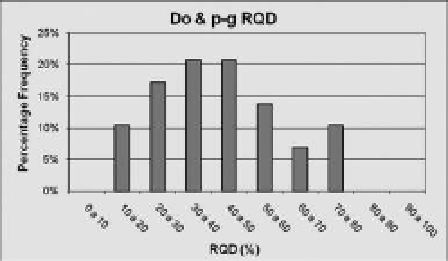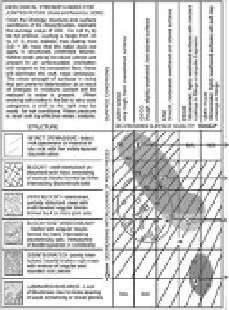Environmental Engineering Reference
In-Depth Information
The p-g unit only affects the north tunnel portal.
This geological unit consists of gabbros and peri-
dotities slightly to highly serpentinized. They can
be are distinguished from the Do unit by its holoc-
rystalline texture. These formations are treated
as one unit due to their similar geo-mechanical
characteristics.
in the analyses of boreholes that encountered
this unit, the intercalations of shale and chert rep-
resent no more than 15% of the total length of the
samples. The thickness of these intercalations is
between 0.50 m and 3.00 m.
The thickness of the layer that consist mainly
of dolerites (serpentinized or not), basalts, gabbros
and/or peridotites is between 2.90 and 30.40 m.
This formation normally presents in the order
of two to three discontinuities per meter and are
moderately to highly fractured in areas. The RQD
rages from 12% and 77%, with an average value
of 43%. Figure 4 shows the statistical analysis of
RQD this formation.
The value of uniaxial compressive strength
measured in specimens of dolerite, basalt, perido-
tite and gabbros ranges from 0.30 MPa to 134.10
MPa, with an average value of 25.0 MPa. The his-
togram in Figure 5 shows the distribution of the
results obtained with this test.
The joints of discontinuity planes are smooth
or slightly rough, sometimes lubricated, closed or
slightly open (<1 mm) with hard filling material.
They are generally slightly weathered or normal.
The Gsi, as estimated from the borehole logs,
varies between 39 and 66, with an average Gsi
of 50. Figure 6 shows the distribution of values
obtained.
in figure 7 it is shown, as a conclusion, a com-
parison of the estimated Gsi values with Marinos
and hoek (2001) recommendations. The main dif-
ference lies in the condition of the joints, signifi-
cantly higher when obtained from boreholes and
not outcrops, where the effect of weathering is
much lower.
3.2.2
Sch-do geotechnical unit
These are layers of shale and/or argillites with
intercalations of cherts, sandstone and thin-
bedded siltstone in continuous alternations with
dolerites and lavas. its mechanical properties vary
depending on the formation with greater presence,
being layers of volcanic rocks (dolerites and lavas)
Do & p-g GSI
70%
60%
50%
40%
30%
20%
10%
0%
GSI
Figure 6. Frequency histogram of estimated Gsi values
from boreholes drilled in the Do & p-g unit.
Figure 4. Frequency histogram of the Ucs and PlT
compressive strength test results in the sch-do unit.
UNIDAD GEOTÉCNICA
Do y p-g
(Dolerita con intercalaciones de
pillow lavas y gabros)
GSI
39 - 66 / 50
Sch-do UCT
1.Massivestrongperidotitewithwidelyspaceddiscontinuities.The
conditions of discontinuities arepoorlyonlyaffectedbyserpentinisation.
2.Goodtofairqualityperidotiteorcompactserpentinitewithdiscontinuities
whichmaybeseverelyaffectedfromalteration.
70%
60%
50%
40%
3.Schistoseserpentinite.Schistositymaybemoreorlesspronouncedand
theirplanesaltered.
30%
20%
4.Poortoverypoorqualityshearedserpentinite.Thefragmentsarealso
consistingfromweakmaterials
10%
0%
Figure 7. Ranges of variation of estimated Gsi for
the do geotechnical unit and p-g on the extracted core
B2o-1 to B2o-8 and superimposed to those proposed by
Marinos and hoek rocks of varying qualities peridotitic,
dolerite and/or serpentinites ofiliticos complexes.
MPa
Figure 5. Frequency histogram of the Ucs and PlT
compressive strength test results in the Do & p-g unit.
































































